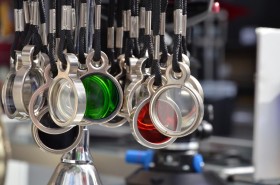With a week to digest Cine Gear Expo, along with the delicious In-N-Out burgers, it’s as risky to analyze the trends we saw on Paramount’s New York Streets as it is to augur the whims of Wall Street. Nevertheless, here goes.
But first we need to talk about art and politics. Equipment is getting cheaper, labor is getting more expensive, and more people are getting into production. Which is why every other camera assistant and camera person wandering the streets of Cine Gear was snapping up equipment and running a sub-rental business with not one but two, four, thirty cameras. This is a phenomenon not seen since the 1970s, when cameras were relatively affordable — about the price of a fancy car. As cameras became more complicated, the cost grew similar to a fancy house. DSLR cameras, RED, and Alexa changed the equation. I met owners of new rental houses that were started within the past year or two. They don’t have any legacy film cameras and many don’t even have hot lights. They are investing in digital cameras and LED lights. Albrecht Gerlach of Photo Cine Rent in Paris and the guys at Redgate in Beijing come to mind.
That’s the politics. The art of the matter comes from the fact that never before have there been more ways to create new looks and new styles. Every production can have its own digitally originated palette. Nicolas Pollachi’s Loumasystems’ HDSystems creates custom gamma curves. Fujifilm’s CCBox lets us create LUTs on set with an iPad. Tiffen’s Dfx software lets us play with digital filters before committing to glass ones.
With all this evolution, one thing remains immutable. It’s still essential to have a couple of boxes of good glass filters in two categories: ND and grads to control the light, and effects filters to control the look.
So, visit Stan Wallace at the Filter Gallery in New York (photo above), Carey Duffy at the London Filter Company, Peter and Bill at Birns & Sawyer, or your friends at Filmtools. Nothing “bakes in” a look more indelibly than a glass filter. This is usually a good thing. However, I remember getting in trouble on a Korean car commercial where we spent many hours digitally trying to negate the effects of all the grads we had carefully used but were later rejected by the absent art director.
And, speaking of filters–although a contrast glass dangling around one’s neck as a badge of office seems superfluous, take a look at the solar viewing glass from the DOP shop to check the heavens for sun and clouds.









Re: ” . . . although a contrast glass dangling around one’s neck as a badge of office seems superfluous . . .” Agreed, but it did force us to view the scene with only one eye which eliminated any illusion of the separation of planes in the scene when seen with both eyes open.
Ross: Very good point. Now…with over 300 projects currently shooting in 3D, perhaps your next business adventure will be to build us binocular contrast glasses!